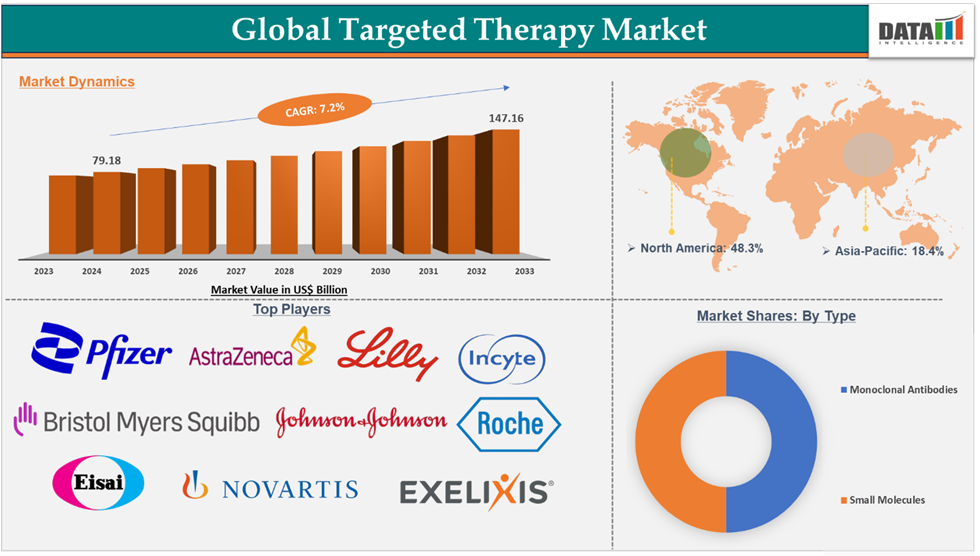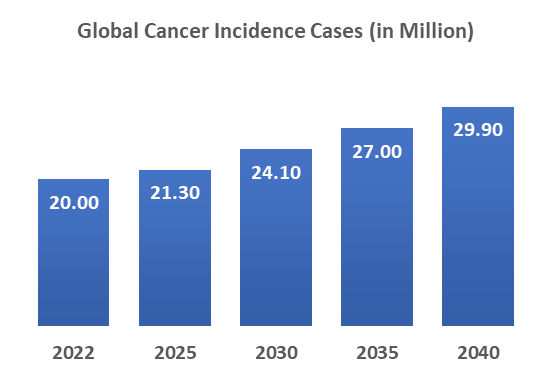Targeted Therapy Market Size
Targeted Therapy Market reached US$ 79.18 billion in 2024 and is expected to reach US$ 147.16 billion by 2033, growing at a CAGR of 7.2% during the forecast period 2025-2033.
The targeted therapy market is experiencing significant growth driven by the rising R&D investments, regulatory approvals, and novel product launches. The innovations in targeted therapy are driven by the rising prevalence of cancer and the growing demand for targeted therapies. However, the high cost of treatment, patient adherence, and compliance issues can significantly hinder the targeted therapy adoption. The emerging markets, such as Asia-Pacific, Latin America, and Eastern Europe, provide an opportunity for market expansion in the forecast period.
Executive Summary

For more details on this report – Request for Sample
Targeted Therapy Market Dynamics: Drivers & Restraints
The rising incidence and prevalence of cancer are driving the market growth
Targeted therapy has evolved as the most promising approach for the treatment of cancer. As the global burden of the disease grows, the demand for these advanced therapies is expected to grow. These targeted therapies are currently designed to treat various types of cancer, a condition with a substantially high number of cases worldwide. The incidence and prevalence of cancer are rising due to various factors, including the aging population, changes in lifestyle, environmental factors, etc.
As per the International Agency for Research on Cancer, globally, nearly 20 million incident cases were reported in 2022. In 2030, nearly 24.10 million cases and in 2040, nearly 29.90 million cases were expected.

This alarming rise in cancer cases is driving demand for targeted therapies, which are increasingly seen as an effective alternative to traditional treatments like chemotherapy, radiation, and surgery.
High Cost of targeted therapies may restrain the market growth
Targeted therapies have evolved as a promising option for cancer, treating the one’s with were once highly mortal. However, these therapies are expensive, and their high cost can significantly hinder their adoption, especially in low to middle-income countries and among patients with partial or no insurance coverage.
For instance, the most popular targeted therapy drug, trastuzumab, sold under the brand name Enhertu, is priced at US$ 3,142.90 for 1 powder for injection. This high cost not only places a significant burden on patients but also strains healthcare systems and insurance providers.
These targeted therapies need frequent administrations to patients to achieve the desired remission, which can further increase overall costs for patients. As a result, the affordability of these treatments may limit their widespread adoption, slow market penetration, and reduce access for patients who could benefit from these advanced therapies. Thus, the above factors could be limiting the global targeted therapy market's potential growth.
Targeted Therapy Market Segment Analysis
The global targeted therapy market is segmented based on type, indication, route of administration, and region.
Monoclonal antibodies in the type segment accounted for 62.5% of the market share in 2024 in the global targeted therapy market
Monoclonal antibodies are the products designed to mimic the antibodies produced by the human body’s immune system. These agents are known to specifically bind to biological receptors and trigger the respective mechanisms. In cancer, these monoclonal antibodies act by binding to various surface receptors of cancerous cells and blocking specific molecules that are involved in tumor growth and survival, such as HER2, EGFR, VEGF, or CD antigens. Unlike traditional chemotherapy, which affects both healthy and cancerous cells, monoclonal antibodies offer a more targeted approach, allowing for increased precision and reduced side effects.
Based on the receptor target, these monoclonal antibodies, which act as targeted therapeutics in cancers, are classified into VEGF Inhibitors, CD Antigen-Targeted mAbs, EGFR Inhibitors, HER2 Inhibitors, etc. These monoclonal antibodies are indicated in various cancers such as breast cancer, colorectal cancer, various leukemias, gynecological cancers, lung cancer, liver cancer, head and neck cancers, etc.
Among these antibodies, HER2 inhibitors have gained huge popularity due to their targeted mechanism in breast cancer, which is one of the most prevalent cancers worldwide. These drugs include Trastuzumab (Herceptin), Pertuzumab (Perjeta), Trastuzumab deruxtecan (Enhartu), Trastuzumab emtansine (Kadcyla), etc. These are among the top-selling targeted therapy drugs currently, and below are their sales values.
Brand | Generic Name | Manufacturer | Sales (2024) in US$ Million |
Perjeta | Pertuzumab | ROCHE | $ 4,109.95 |
Kadcyla | Trastuzumab emtansine | $ 2,270.93 | |
Phesgo | pertuzumab, trastuzumab, and hyaluronidase-zzxf | $ 1,977.68 | |
Herceptin | Trastuzumab | $ 1,569.64 |
Targeted Therapy Market Geographical Analysis
North America dominated the targeted therapy market with the highest share of 48.3% in 2024
North America is the region with an advanced healthcare industry. The region's dominance in the targeted therapy is mainly attributable to a higher proportion of sales generated by key manufacturers from the region. For instance, F. Hoffmann-La Roche Ltd, a key player in the targeted therapy market, has generated 33.71% from the United States, from the sales of its HER2 inhibitors portfolio (total sales: US$ 9,928.20; US Sales: US$ 3,347.29)
Moreover, research activities related to cancer are higher in the region due to favorable funding and high investments, which help manufacturers develop and launch novel therapies. In addition, the favorable reimbursement scenario in the region makes the highly expensive drugs available at affordable prices to the patients, making them accessible to those in need. Also, due to stringent regulatory guidelines for product approval, the launch of target therapies in the U.S. initially will provide a positive nod for universal acceptance, hence, the majority of the product innovators focus on launching their product initially in this region.
Targeted Therapy Market Major Players
The major players in the targeted therapy market are F. Hoffmann-La Roche Ltd, Novartis AG, Pfizer Inc., AstraZeneca, Eisai Inc., Johnson & Johnson Services, Inc., Bristol-Myers Squibb Company., Incyte, Eli Lilly and Company, and Exelixis, Inc., among others.
Key Development
In May 2025, the U.S. Food and Drug Administration (FDA) provided accelerated approval for EMRELIS (telisotuzumab vedotin-tllv) developed by AbbVie, for the treatment of adult patients with locally advanced or metastatic, non-squamous non-small cell lung cancer (NSCLC) with high c-Met protein overexpression (OE) who have received a prior systemic therapy.
In March 2025, Genmab A/S announced that the Japan Ministry of Health, Labour and Welfare approved TIVDAK (tisotumab vedotin) for the treatment of advanced or recurrent cervical cancer that has progressed on or after cancer chemotherapy. TIVDAK is an antibody drug conjugate that received first approval in Japan for cervical cancer patients.
In October 2024, Genentech a member of the Roche Group, announced that the U.S. FDA approved Itovebi (inavolisib) a targeted therapy, in combination with palbociclib (Ibrance) and fulvestrant, for the treatment of adults with endocrine-resistant, PIK3CA-mutated, hormone receptor (HR)-positive, human epidermal growth factor receptor 2 (HER2)-negative, locally advanced or metastatic breast cancer.
Market Scope
Metrics | Details | |
CAGR | 7.2% | |
Market Size Available for Years | 2022-2033 | |
Estimation Forecast Period | 2025-2033 | |
Revenue Units | Value (US$ Mn) | |
Segments Covered | Type | Monoclonal Antibodies, Small Molecules |
Indication | Leukemia, Breast Cancer, Lung Cancer, GI Cancers, Melanoma, Others | |
Route of Administration | Oral, Parenteral | |
Regions Covered | North America, Europe, Asia-Pacific, South America, and the Middle East & Africa | |